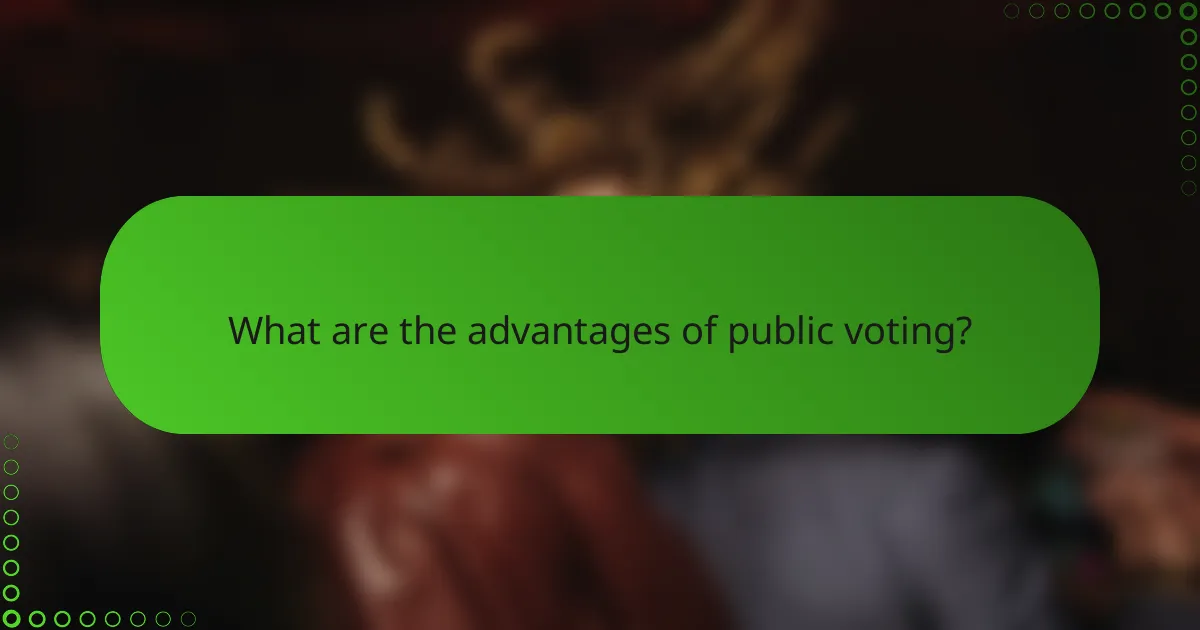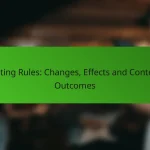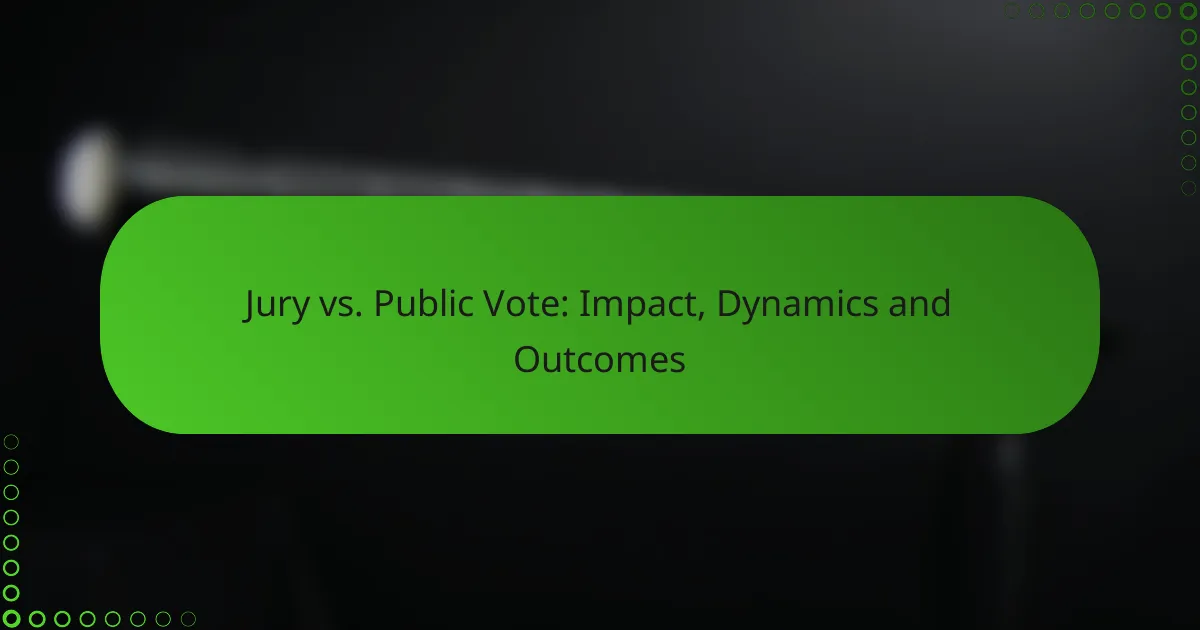The debate between jury voting and public voting highlights the contrasting dynamics and impacts on outcomes in various competitions and decision-making processes. Jury voting relies on the expertise of selected judges, promoting informed decisions, while public voting can reflect popular sentiment, often influenced by social media and engagement levels. Each method presents unique challenges regarding fairness and transparency, shaping the integrity of the results.

How does jury voting impact outcomes in competitions?
Jury voting significantly influences outcomes in competitions by leveraging the expertise of selected judges to evaluate performances or submissions. This method often leads to more informed and nuanced decisions compared to public voting, which can be swayed by popularity rather than merit.
Influence of expert judgment
Expert judgment plays a crucial role in jury voting, as jurors typically possess specialized knowledge in the competition’s field. Their insights can lead to more accurate assessments, ensuring that the best entries are recognized. For example, in art competitions, a jury of experienced artists can evaluate technical skill and creativity more effectively than a general audience.
Moreover, expert jurors can provide constructive feedback, helping participants improve their work for future competitions. This mentorship aspect is often lacking in public voting scenarios.
Consistency in decision-making
Jury voting tends to promote consistency in decision-making, as jurors follow established criteria and guidelines when evaluating entries. This structured approach minimizes the variability that can arise from public votes, which may fluctuate based on trends or emotional responses. For instance, in film festivals, jurors assess films based on predetermined categories such as direction, acting, and screenplay.
However, it is essential for jurors to remain impartial and avoid biases that could affect their evaluations. Regular training and clear communication of standards can help maintain this consistency.
Legal implications of jury decisions
The legal implications of jury decisions can be significant, particularly in competitions with monetary prizes or contractual agreements. Jurors must adhere to ethical standards and avoid conflicts of interest to ensure fair outcomes. For instance, if a juror has a personal relationship with a contestant, it could lead to claims of favoritism.
Additionally, the decisions made by a jury can be subject to review or appeal, depending on the competition’s rules. Participants should familiarize themselves with these regulations to understand their rights and the potential for contesting a decision if necessary.

What are the dynamics of public voting?
Public voting involves citizens casting their votes on various issues or candidates, often influencing outcomes significantly. The dynamics of public voting are shaped by factors like voter engagement, social media influence, and shifting public opinion.
Voter engagement and participation
Voter engagement is crucial for the success of public voting initiatives. High participation rates often correlate with well-informed voters who understand the stakes involved. Strategies to enhance engagement include outreach campaigns, educational resources, and simplifying the voting process.
To boost participation, organizations can utilize reminders through emails or social media, encouraging individuals to vote. Additionally, making voting accessible—such as providing online options or extending voting periods—can significantly increase turnout.
Impact of social media on public votes
Social media plays a pivotal role in shaping public votes by facilitating discussions and spreading information rapidly. Platforms like Twitter and Facebook can amplify messages, mobilizing voters and influencing their opinions. However, misinformation can also spread quickly, potentially skewing public perception.
It’s essential for voters to critically evaluate the information they encounter on social media. Engaging with credible sources and fact-checking claims can help mitigate the effects of false information and lead to more informed voting decisions.
Trends in public opinion
Public opinion trends can shift rapidly, often influenced by current events, media coverage, and social movements. Tracking these trends is vital for understanding how they may affect public voting outcomes. Polls and surveys are commonly used tools to gauge public sentiment and predict voting behavior.
Being aware of these trends allows organizations and candidates to adjust their strategies accordingly. For instance, if a particular issue gains traction, campaigns may focus more resources on addressing that concern to align with voter priorities.

How do jury and public votes compare in fairness?
Jury votes and public votes each have unique fairness considerations. Jury selections can be influenced by biases, while public voting often lacks transparency, affecting the perceived integrity of the process.
Bias in jury selections
Jury selections can be subject to various biases, including racial, socioeconomic, and educational factors. These biases may lead to a jury that does not accurately represent the community, potentially skewing verdicts. For instance, a jury composed predominantly of one demographic may not fully understand the perspectives of others involved in the case.
To mitigate bias, courts often implement measures such as voir dire, where potential jurors are questioned to identify any prejudices. However, these measures are not foolproof, and biases can still influence the final jury composition.
Transparency in public voting
Public voting is generally more transparent than jury voting, as the process is open to scrutiny by the public and media. However, transparency can vary significantly depending on the voting system and regulations in place. For example, in some countries, the anonymity of voters can lead to questions about accountability and the legitimacy of the results.
To enhance transparency, jurisdictions can adopt measures like open ballot systems or detailed reporting of voting processes. This helps build public trust in the outcomes, especially in high-stakes elections or referendums.
Statistical analysis of outcomes
Statistical analysis reveals that jury decisions can be less predictable compared to public votes, which often reflect broader public sentiment. Studies indicate that juries may take longer to reach a consensus, with deliberation times varying widely based on case complexity. In contrast, public votes tend to yield quicker results, often within hours of polls closing.
When analyzing outcomes, it’s essential to consider factors such as the size of the jury versus the number of public voters. For example, a jury may consist of 12 individuals, while public votes can involve thousands or millions, leading to different dynamics in decision-making and representation.

What are the advantages of jury voting?
Jury voting offers several advantages, including informed decision-making by a diverse group and a reduction in the impact of popularity on outcomes. This method can lead to fairer and more balanced results, especially in competitive environments.
Expertise in decision-making
Jury voting typically involves individuals with varying levels of expertise relevant to the subject matter. This diversity allows for a more comprehensive evaluation of the options, as jurors can bring different perspectives and insights to the table.
For example, in a film competition, jurors may include filmmakers, critics, and industry professionals, each contributing their unique knowledge. This collective expertise can enhance the quality of the decision-making process.
Reduced influence of popularity
One significant advantage of jury voting is its ability to minimize the influence of popularity contests. Unlike public voting, where popularity can skew results, jury members focus on the merits of the entries rather than their public appeal.
This approach ensures that less mainstream but high-quality options receive fair consideration. For instance, an independent film might not have the same audience as a blockbuster but could be recognized for its artistic value through jury evaluation.
Legal authority of decisions
Decisions made by a jury often carry legal authority, especially in formal settings such as court cases or regulatory approvals. This authority lends credibility to the outcomes, as they are typically based on established criteria and thorough deliberation.
In contexts like award shows or competitions, jury decisions can also be seen as more legitimate than public votes, as they are made by individuals who are knowledgeable about the field. This can enhance the prestige of the awards and encourage higher standards in submissions.

What are the advantages of public voting?
Public voting offers several benefits, including enhanced representation of diverse opinions and increased engagement from the audience. It allows a wider range of voices to be heard, which can lead to more democratic outcomes.
Broader representation of opinions
Public voting captures a wider array of perspectives compared to jury-based systems. This inclusivity ensures that decisions reflect the views of a larger segment of the population, rather than a small, potentially biased group.
For example, in competitions or decision-making processes, public voting can include input from various demographics, leading to outcomes that resonate more broadly with the community. This can be particularly important in cultural events where diverse tastes and preferences are at play.
Increased audience engagement
Public voting actively involves the audience, fostering a sense of participation and investment in the outcome. When people have a say in the decision-making process, they are more likely to feel connected to the event or issue at hand.
Engagement can be amplified through social media platforms, where participants can rally support and share their opinions. This interaction not only boosts interest but also encourages discussions that can enrich the overall experience.
Flexibility in voting methods
Public voting allows for various voting methods, accommodating different preferences and accessibility needs. Options can include online voting, mobile apps, and traditional paper ballots, making it easier for more people to participate.
This flexibility can lead to higher turnout rates, as individuals can choose the method that suits them best. For instance, online voting can attract younger audiences who are more comfortable with digital platforms, while traditional methods can ensure inclusivity for those less tech-savvy.

How do cultural factors influence voting methods?
Cultural factors significantly shape the choice between jury and public voting methods, impacting how decisions are made in various contexts. These influences can include societal values, historical precedents, and the perceived legitimacy of different voting systems.
Regional preferences for jury vs. public votes
Different regions exhibit distinct preferences for jury or public voting systems based on cultural norms and historical practices. For instance, many Western countries, such as the United States and Canada, favor jury systems for legal decisions, reflecting a belief in peer judgment. In contrast, some Eastern cultures may lean towards public voting methods, valuing collective consensus over individual opinions.
These preferences can influence not only legal systems but also community decisions, such as local governance or public initiatives, where public votes may be seen as more democratic and inclusive.
Historical context of voting systems
The evolution of voting systems is deeply rooted in historical events and cultural shifts. For example, the establishment of jury trials in England during the Magna Carta period emphasized the importance of citizen participation in justice. This historical context has led to a strong tradition of jury systems in many English-speaking countries.
Conversely, public voting systems have gained traction in societies that prioritize direct democracy, such as Switzerland, where referendums are a common practice. Understanding these historical backgrounds helps clarify why certain regions prefer one voting method over another.
Case studies from various countries
Examining specific countries reveals the practical implications of cultural factors on voting methods. In the United States, jury trials are a cornerstone of the legal system, reflecting a cultural emphasis on individual rights and peer judgment. This system is often viewed as a safeguard against government overreach.
In contrast, countries like Sweden utilize public voting extensively for legislative decisions, showcasing a cultural inclination towards collective decision-making. This method fosters a sense of community involvement and accountability, aligning with Sweden’s social democratic values.
These case studies illustrate how cultural factors not only influence the choice of voting methods but also shape the outcomes and public perceptions of legitimacy in different contexts.










